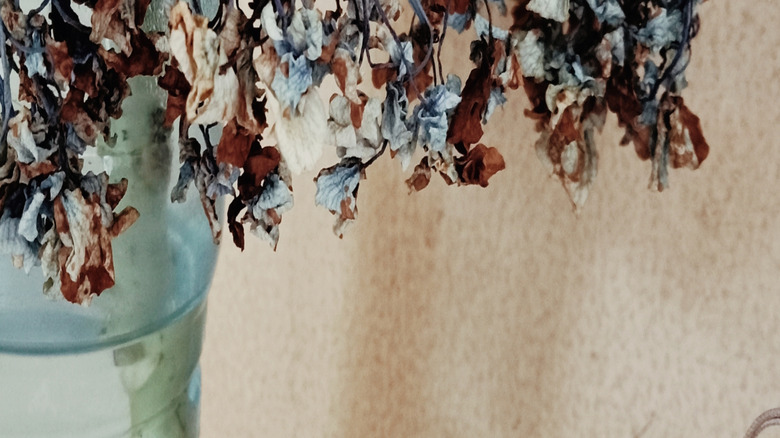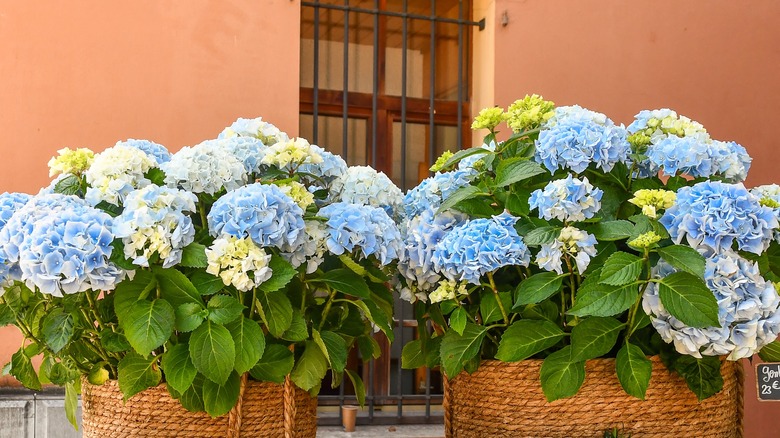Why Your Potted Hydrangeas Keep Dying (& How To Properly Care For Them)
Potted hydrangeas are a popular holiday gift, but some people have such bad luck keeping them alive that even a bouquet would last longer. The truth is, hydrangeas are more often grown as outdoor flowering shrubs, and they're not as low-maintenance or long-lasting as your average houseplant. However, they can thrive in containers when grown outdoors, and you can take steps to keep them alive and beautifully blooming indoors for longer.
Potted hydrangeas are a great alternative for those without enough outdoor space to grow a full shrub. There are many dwarf varieties available that are ideal for containers, including Hydrangea paniculata and Hydrangea macrophylla. The latter is also the best hydrangea for indoor use. If you've been given a potted hydrangea as a gift, you may not know exactly what variety it is or what hydrangea mistakes to avoid at all costs. Hydrangeas are fussy enough that some people see wilting within a few days and wonder what could have gone wrong so quickly.
On the other hand, these early signs mean you can act quickly and save your hydrangeas. Wilting doesn't necessarily mean your beloved hydrangeas are dying. They may just need a nice deep drink of water or the right amount of sunshine to stay in top shape. And if you want your hydrangeas to last for seasons to come, you'll have to allow them to experience natural seasons while protecting them from freezing temperatures.
Ways to keep potted hydrangeas alive
Temperature is an important consideration with potted hydrangeas. They prefer around 50 to 60 degrees Fahrenheit — not too hot, not too cold. Potted hydrangeas also need at least four hours of sun per day, with shade during the hottest parts of the afternoon. They require a period of winter dormancy to flower again the next season, which is why keeping them indoors year-round isn't feasible long-term; many gifted hydrangeas are actually intended for temporary use. Growing hydrangeas outdoors is simpler and more likely to yield satisfying results.
Whether indoors or outdoors, some of the same common issues can apply. Your potted hydrangea's blooms should last a few weeks to a few months with the right variety and care. Just like wilting, losing flowers isn't necessarily a sign that your hydrangeas are dead, since flowers are temporary by nature and typically only happen once per year. (Gifted hydrangeas from florists have often been forced to bloom out of season.)
If the flowers are dropping prematurely or you notice wilting, you may not be watering enough. Hydrangeas need consistently moist soil, and potted plants need more frequent watering than those in the ground. Flowers require even more water, especially in hot weather. You may need to water as often as daily to keep the flowers going. Hydrangeas visibly wilt when thirsty, which makes it easy to see when you need to adjust. Drench your hydrangeas until water drains out of the bottom of the pot. To avoid overwatering, don't water again until the top of the soil is semi-dry.
Caring for potted hydrangeas
Choosing the right hydrangea is the first key to success. Dwarf varieties are best for containers, and gifted florist hydrangeas may or not be able to survive outdoors in your garden since they're often bred for temporary indoor use. The type of pot is equally important. Hydrangea pots should be at least 18 to 24 inches to accommodate root growth, and they need plenty of drainage. Hydrangeas are flexible with soil, growing well in both alkaline and acidic mixes. The pH of the soil or fertilizer can affect the color of the flowers. Don't fertilize your new potted hydrangea until the next spring since the potting mix contains plenty of nutrients.
Some factors depend on the hydrangea variety, like the amount of sunlight it can tolerate and when to prune. But consistent watering is always a must, and distilled water or rainwater is best. Protecting your hydrangeas from cold weather is also essential. Bringing them indoors may not work because they need to experience dormancy; on the other hand, a deep freeze can be deadly. Adding mulch, burlap, and/or frost cloth will help insulate them just enough from the cold. You can also bring hydrangeas to a protected area that still gets enough sun.
Want to give your indoor hydrangeas a shot at re-blooming? It's tricky, but can be done if you mimic the natural seasons. This includes steps like cutting the branches back after blooming, keeping the plant in a cooler location over the winter, and pinching off all of the leaves if they don't drop. Putting the plant outdoors for part of the year still tends to work best.


